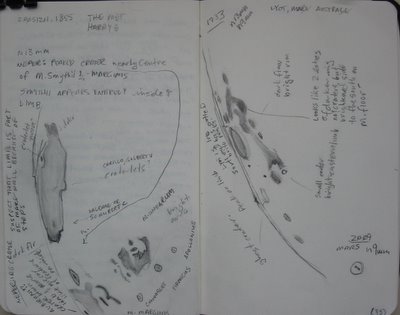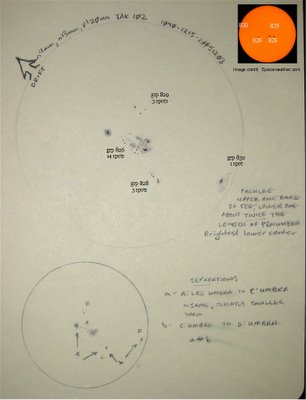20051213 - Magnificent Desolation
Buzz Aldrin described the lunar landscape when he walked across its surface in 1969 as "a magnificent desolation." Those words became crystallized for me during last night's observing session at the Top of the Lawn (TotL). I was captured and mesmerized by the detail and beauty of crater Bailly, prominently dimpling the bottom of Moon on the edge of the terminator. It was here that I transported to that world of grays and black, freezing in the darkness of shadow, boiling in the sun's light.
I had gone out for two observing sessions - one with the 6" F/6 reflector behind the statue inside the south end of Central Park. This was a 90 minute session began around 3:00pm for observing and sketching the eastern librated maria. I found that sketching with this setup is more comfortable since I can adjust the eyepiece to where I'm standing straight up and not crouching.
Later, I would meet up with Charlie and Kin at TotL. They each brought their binoculars and I brought the 4" Takahashi refractor. I arrived shortly after Charlie and when we were standing around talking during cool down, Charlie spotted a bright meteor falling to our west. He pointed and I looked around an even saw for it for a couple of seconds - very bright with "sparkles" in the ball and a short tail. That would be the brightest of a dozen meteors we would see collectively through out the night. Kin spotted 2, Charlie 4, and I saw 7. I saw two meteors falling together almost side by side just south east (from our perspective) of two landmark buildings on our southwestern horizon, The Beresford. At times I felt I saw other less bright meteors with peripheral vision though I didn't count nor mention them to the others. Perhaps, the same was happening for them. With a bright waxing gibbous Moon, no doubt there were others that just got washed out. In fact when we looked at M42, the nebula was suffered from a bright background sky.
I regret that I didn't pull out the notebook and begin to sketch what we were observing along the terminator in the south southwest of Moon. But kneeling on towels and slightly crouched to a refractor pointing almost zenith in teen degrees Fahrenheit is not conducive to sketching. (It is also apparently obvious how a tracking mount would be more convenient.) Really I chickened out. Visiting the sketch gallery in Belt of Venus, and following the links that Jeremy provides there, I let a lasting impression defeat me for the moment. Not next time.
Three nearly equal sized craters - Zucchius, Bettinus, and Kircher - arced above Bailly. One can see them lower left (8:00 to) to the great ray crater Tycho on Vern's blog. Charlie & I observed Bailly at 182x and even as high as 325x. (At 325x, the dirt on my lens really stood out.) In both cases the seeing held up, with only occasional blurring. The detail was amazing seeing small rilles and craterlets on the floor and north eastern rim. The crater was half in shadow, black, and half illuminated. A ridge appeared to run across the length of the crater with one prominent crater Bailly B with an encroaching smaller crater in its eastern wall, further west-northwest along this central ridge and where the shadow fell, part of another crater was observed. Three broad shadows ribbed along the southern rim of crater Bailly like pinstripes. Bailly B's was responsible for the one to the east, forming an hour glass shape. To the west the partial crater was responsible for the middle shadow on the wall, and we didn't identify what projected the third shadow, perhaps a peak on that ridge. This map image displays something similar to what we observed.
Nearby Bailly, we observed three interesting craters - Wargentin, Nasmyth, and Phocylides. It was evident that Nasmyth was on Moon first, later to be partially overlapped by Phocylides. Wargentin was Escher-esque as it appeared as a "raised plateau" contrasting with the depressed craters Nasmyth & Phocylides. (One can see this effect in the image referred to above for Bailly.) The shadow along its northeastern rim appeared proper and then a bright round crater floor. The southern wall's shadow was very pronounced but the interior part of this wall was not seen. Thus it appeared as if the plateau fell sharply along the south.
At the end of the session we would observe Saturn and Mars. I was surprised by what we saw of dinky, little Mars. The was an obvious upside "Y" shape running vertical to the disk in the eyepiece. I mentioned to Charlie that could be Syrtis Major. Checking Brian Tung's Mars Map it didn't show up. Returning to the app today, I setup the time for 14 Dec 2005 00:45 and there was Syrtis Major.
This past month or so has been mostly Solar System whether by day or by night. Sometimes I get into the challenge of the deep sky hunt for the urban astronomer that I almost ignore our closest neighbors in the shallow sky. Nice to know Moon can keep me at bay.








